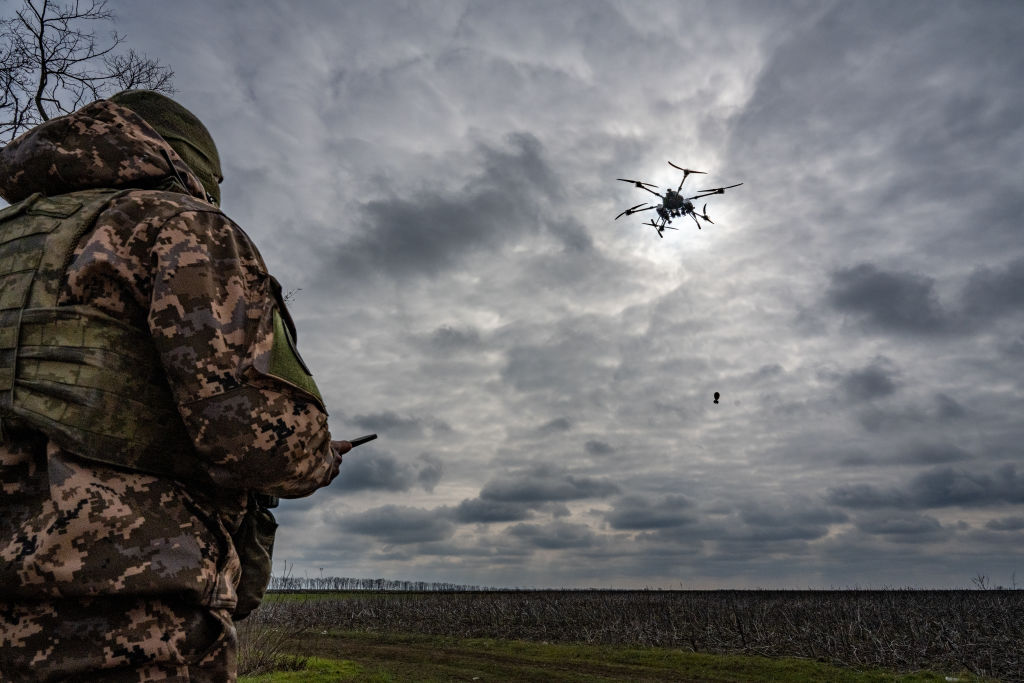Pentagon shopping for ‘low-cost, one-way’ drones with extended ranges

Acknowledging the changing nature of modern conflict, the Pentagon’s Defense Innovation Unit is on the hunt for “low-cost, one-way unmanned aerial systems” from commercial providers that can traverse extended ranges of up to several hundred kilometers.
DIU issued a solicitation this week “seeking commercial solutions for ground-launched, one-way UAS platforms that can operate at ranges from 50-300 km+, launch quickly and expeditiously, navigate at low altitudes, carry a variety of payloads, and operate beyond line of sight in disrupted, disconnected, intermittent and low-bandwidth (DDIL) and Global Navigation Satellite System (GNSS) denied environments.”
Such drones have become commonplace in ongoing conflicts abroad, including in Ukraine and the shipping lanes of the Red Sea, where the U.S. Navy is facing a barrage of complex attacks from the Iran-backed Houthis. The solicitation explains: “Recent conflicts have highlighted the asymmetric impact low-cost, one-way unmanned aerial systems (UAS) have on the modern battlefield.”
“The Department of Defense (DoD) must be able to employ low-cost precision effects at extended ranges,” it continues. “Reliable, affordable, and adaptable long-range UAS platforms that allow for employment at scale will maximize operational flexibility for the Joint force.”
DIU’s commercial solution offering comes as the Department of Defense, at the order of Deputy Defense Secretary Kathleen Hicks, has undertaken an effort known as Replicator to deter China by incentivizing and accelerating industrial production capacity and the military’s adoption of attritable, autonomous systems in multiple combat domains — through replicable processes — by mid-2025.
Earlier this week, DefenseScoop was the first to report news of the focus of Replicator 2.0 to accelerate high-volume production of technologies designed to detect, track and destroy enemy drones. However, the first capability focus area for Replicator has broadly encompassed the purchase and making of loitering munitions, and other technologies associated with what Hicks refers to as “all-domain attritable autonomous systems” (ADA2) to counter China’s anti-access/area-denial A2AD strategy.
DIU spells out in its solicitation that it’s looking for a “low-cost, ground-launched, unmanned aerial system that can carry a 10 kg payload (ideally 25+ kg) over 50 km (ideally 300+ km)” that is “capable of supporting high-speed, low-altitude, beyond line of sight flight operations in [disrupted, disconnected, intermittent, and low-bandwidth] environments.”
The unit is also prioritizing systems that have integrated mission planning software and can quickly “integrate third-party software and hardware components (including payloads) in a modular, warm-swappable manner.”
Related
Exclusive | Dave Portnoy is quietly shopping a book
Barstool Sports founder Dave Portnoy is shopping a book, Page Six has exclusively learned. Portnoy’s agency UTA is repping the tome, sources te
We Track Sales For A Living. Here Are The 30…
As shopping experts, we shop slowly and carefully to discern if a sale offers the most bang for our buck. From everyday essentials to larger splurges, knowing w
Can you afford to be patriotic when grocery shopping?
CBCPenguins bask on the shore of King George Island near Brazil's Comandante Ferraz research station in Antarctica.Antarctica is like no place on Earth. The "W
Our Readers Top Loved Products Last Month Were All Sleep…
1TOP-TESTED COTTON SHEETSCalifornia Design Den Cotton SheetsNow 23% OffCredit: California Design DenWhy we love it: If you have been reading our What's In My Ca











